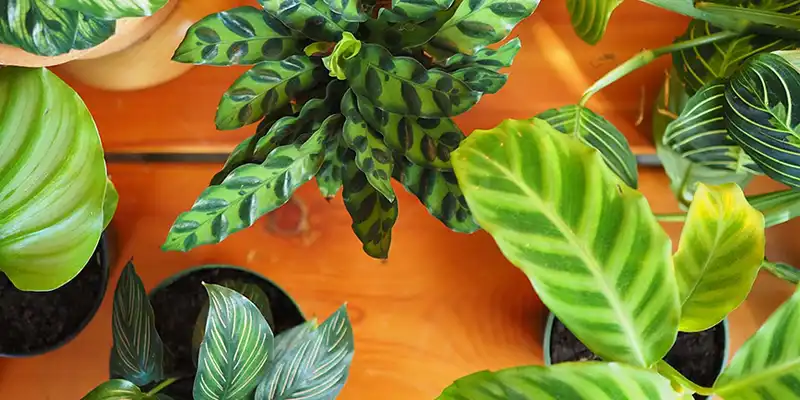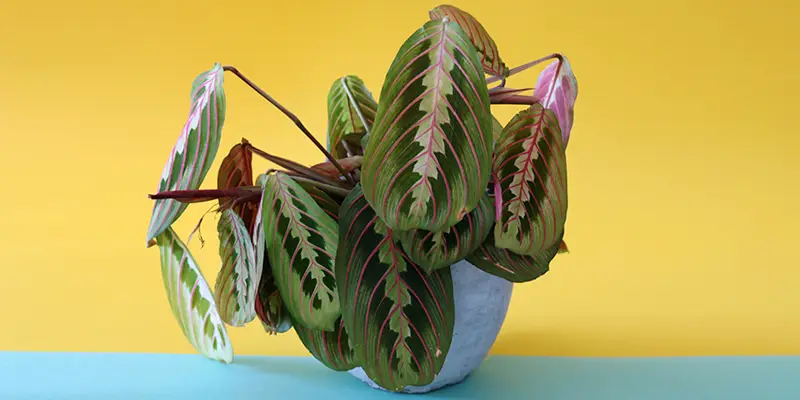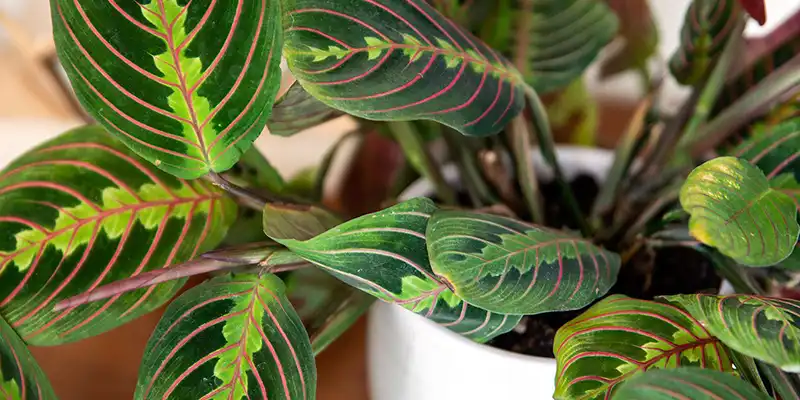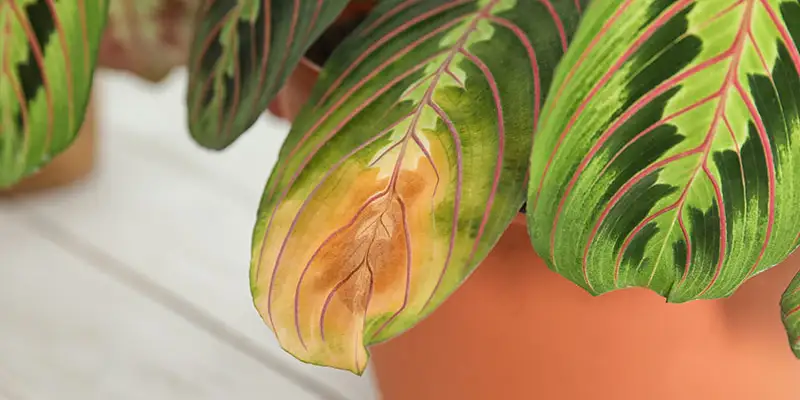The prayer plant is a remarkable indoor plant that flourishes best in humid environments, yet is notably sensitive to light. Originating from tropical regions, the prayer plant, much like its counterparts, acts as a natural air purifier, removing harmful gases and toxins. Read on to delve deeper into the advantages of the prayer plant and guidance on its proper care.
What Are Prayer Plants?
Maranta leuconeura, commonly known as the prayer plant, belongs to the Marantaceae family, which also encompasses ‘arrowroot.’ Indigenous to Central and South America, it is particularly prevalent in the Brazilian rainforests. The plant is characterized by its expansive, velvety, oval leaves adorned with intricate designs.
Suited for compact containers with shallow root structures, like half pots or flat pots, the prayer plant is an ideal addition to modest-sized kitchens or bathrooms. With diligent care, the Maranta plant stands out as one of the most stunning indoor plants one can cultivate.
Why Is It Called a Prayer Plant?
As evening descends, the light-green leaves of the plant elevate, resembling a gesture of prayer, only to revert to their customary horizontal orientation by day. This adaptive movement enables the prayer plants in the rainforest to gather rainfall in their uplifted leaves, channeling it efficiently towards their roots.
Types of Prayer Plants

When perusing prayer plants for purchase, the following are some of the most prevalent types you may encounter:
● Red Prayer Plant (Maranta leuconeura ‘erythroneura’): This variant boasts striking fuchsia pinstripes atop its leaves, while the underside presents a vibrant shade of purple, as described by Gubler.
● Lemon Lime Prayer Plant (Maranta leuconeura ‘marisela’): Characterized by its pronounced veins, similar to the Red Prayer Plant, this type displays a delicate hue of light green interspersed with white.
● Green Prayer Plant (Maranta leuconeura): Often referred to as the rabbit’s foot plant, this specimen is distinguished by its more subtle veining and prominent dark green patches on the leaf surface, distinguishing it from its counterparts.
Prayer Plant Benefits

The Prayer Plant, with its vibrant and tropical appearance, serves as a delightful addition to any living space, invariably elevating one’s spirits upon sight. Its radiant hues undeniably enhance one’s mood. Numerous studies have underscored the benefits of plants in bolstering mental well-being and instilling a sense of grounding.
1. Symbolism
The prayer plant’s leaves, which stand erect and fold in a manner reminiscent of clasped hands, symbolize gratitude. When presented as a gift, it further embodies expressions of thankfulness and appreciation. In certain cultures, it is believed to attract positive energy and bestow good fortune.
2. Absorbs Pollutants
A NASA clean air study revealed that certain houseplants can mitigate pollutants, such as formaldehyde and benzene, in the ambient air. While the prayer plant was not specifically listed in this study, there’s a plausible assumption that it, too, possesses the capacity to neutralize these contaminants. As noted by CNBC, indoor air pollution can sometimes pose greater health risks than its outdoor counterpart.
3. Prayer Plants Reduce Stress
Houseplants, such as the prayer plant, possess a tranquilizing influence that alleviates feelings of stress and anxiety. Interaction with plants induces a soothing effect on our sympathetic nervous system, leading to a decline in diastolic blood pressure and engendering a profound sense of well-being. This diminution in stress and anxiety augments concentration, subsequently enhancing productivity.
4. Ease of Maintenance
Urban residents, often preoccupied with numerous responsibilities, naturally gravitate towards houseplants demanding minimal care. The prayer plant is one such low-maintenance specimen, seeking only bright, indirect sunlight, well-draining soil, and a high humidity environment to flourish.
5. Prayer Plants Require Little Space
Prayer plants have relatively shallow roots, making them well-suited for shallow containers. Typically, they reach a modest height of 10-12 inches (25.4-30.5 cm) and expand to a width of 15-18 inches (38-45.7 cm) when their leaves are fully spread. Consequently, they serve as an elegant focal point, even in compact living or work environments.
6. Prayer Plants Have Eye-Catching Foliage
Unlike some houseplants that frequently require transplantation due to rapid growth, prayer plants exhibit resilience and tend to remain within the confines of their initial spaces. While they boast diverse foliage, they do not yield ostentatious flowers, rendering them perfect as understated decorative elements.
How To Grow Prayer Plants in Indoors

Prayer plants are relatively easy to cultivate indoors. In this discussion, we’ll highlight key aspects of their care. Ideally, they flourish in environments similar to a temperate greenhouse, with mild to warm daytime temperatures and consistently moist soil.
● These plants prefer moist, well-draining soil. Even though they have an affinity for tropical conditions, they are gratifying to cultivate due to their low maintenance needs.
● They can adapt to low, medium, or high light settings. If exposed to bright light, ensure to use a sheer curtain or another means to protect the leaves from direct sun.
● Watering should be conducted once the soil’s surface starts to feel dry. While this resilient indoor plant favors consistent moisture, it should not remain waterlogged. Leaves that dry excessively or too often might acquire a brown hue.
● Fertilization needs are minimal for the prayer plant. A once or twice annual application, preferably in spring or summer, suffices for its health. However, if one desires, more frequent fertilization can be carried out. Utilize standard houseplant fertilizer and adhere to the provided guidelines.
● While the prayer plant is partial to elevated humidity levels, it adapts well to typical household conditions. During drier winter months, augmenting humidity around your plant can be beneficial.
Best Location for Your Prayer Plant
Prayer plants can be cultivated in either planters or hanging baskets. While they are versatile about their location, they should be shielded from direct sunlight. Although these plants favor warmth, excessive sun can cause their leaves to become parched and wither. Optimal conditions involve bright, yet indirect, sunlight. It’s worth noting that prayer plants are also adept at prospering in areas with minimal light.
Should you find the need to position your prayer plant in an area with direct sunlight, consider safeguarding its leaves by employing a sheer curtain or another form of sun barrier. Ideally, place them in a room with southern or western exposure, ensuring they receive light without the harm of direct sun. As they naturally gravitate towards the light, they’ll maintain a lush, green appearance without becoming elongated or thin.
Common Prayer Plant Problems

Caring for prayer plants is relatively straightforward, but adherence to specific guidelines is essential for their optimal growth. Here are some potential challenges and solutions when tending to your prayer plant:
Humidity Deficiency
Originating from rainforests, prayer plants have a predilection for high humidity. Should the humidity drop significantly, you’ll notice the leaves turning brown as a sign of distress. To address this, consider placing a humidifier in the same room as the plant or situating a water-filled dish nearby to boost ambient moisture.
Too Much or Too Little Water
It’s crucial to maintain a keen eye on the moisture content of the soil. Being prone to drought-related stress, prayer plants can wither if they undergo prolonged dehydration. Ensure the soil remains consistently damp.
After watering, allow excess water to drain, preventing the plant from standing in stagnant water. During the cooler months, reduce the frequency of watering, but ensure the soil never becomes entirely parched.
Pests
When cultivating prayer plants outdoors or in gardens, they might become susceptible to pests like spider mites, mealybugs, and aphids. If you observe unusual signs on the leaves, such as web-like structures, white powdery residues, or peculiar spotting, it’s advisable to apply a natural pesticide to combat these invaders. Ensure that the prayer plants are spaced adequately apart to facilitate proper airflow, which can deter the onset of pests and diseases.
It’s imperative to regularly monitor your plants—perhaps during routine watering or feeding sessions—for any indications of infestations or diseases. These issues often arise without warning, so proactive surveillance can aid in early detection, minimizing potential harm.
Conclusion
Prayer plants are highly sought-after for their distinctive leaf patterns and uncomplicated care requirements, positioning them as exemplary indoor plants. Their advantage lies in their relatively low-maintenance nature; with just a modicum of care and consistent soil moisture, they flourish in most domestic settings.
Beyond their aesthetic appeal, prayer plants excel as natural air purifiers, effectively eliminating harmful chemicals and enhancing air quality, which can, in turn, boost respiratory health, sleep quality, and cognitive clarity. Additionally, they possess antioxidant, anti-inflammatory, and antimicrobial properties.




